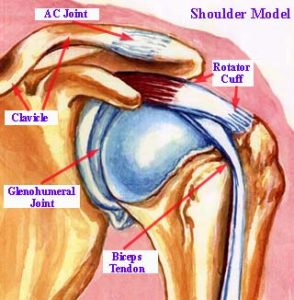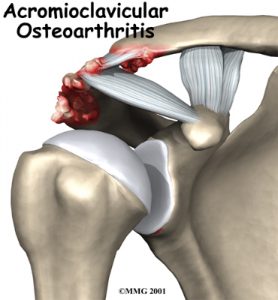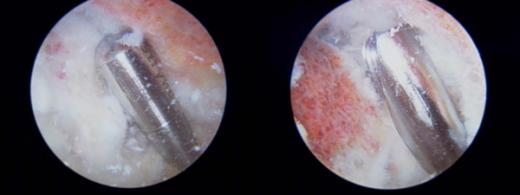What is the anatomy of the shoulder AC joint?
 The top of the wing bone or scapula is the acromion. The joint formed where the acromion connects to the collar bone or clavicle is the AC joint. Usually there is a protuberance or bump in this area, which can be quite large in some people normally. This joint, like most joints in the body, has a cartilage disk or meniscus inside and the ends of the bones are covered with cartilage. The joint is held together by a capsule, and the clavicle is held in the proper position by two heavy ligaments called coracoclavicular ligaments.
The top of the wing bone or scapula is the acromion. The joint formed where the acromion connects to the collar bone or clavicle is the AC joint. Usually there is a protuberance or bump in this area, which can be quite large in some people normally. This joint, like most joints in the body, has a cartilage disk or meniscus inside and the ends of the bones are covered with cartilage. The joint is held together by a capsule, and the clavicle is held in the proper position by two heavy ligaments called coracoclavicular ligaments.
What is AC arthritis?
When the articular disk between the clavicle and acromion begins to degenerate and become painful, AC arthritis results. Fractures of the distal clavicle and AC dislocations may predispose this joint to osteoarthritis. Repetitive upper-extremity activity can cause mechanical wear of the articular cartilage. Changes of the AC joint on x-ray is fairly common, with almost 62% of the dominant arms of those who participate in occupations and sports that require extensive shoulder use showing degeneration. Fortunately, despite the frequency of degenerative changes, few people become symptomatic and require treatment.
What are the symptoms of AC arthritis?
 Common clinical complaints of those who have AC arthritis are diffuse, lateral shoulder pain and/or local AC-joint pain. Pain at night is common. The physical exam commonly reveals local tenderness to palpation of the involved joint. Active and passive range of motion of the shoulder may intensify symptoms. Crossed-arm adduction of the involved shoulder with additional passive adduction by the examiner also aggravates pain. X-rays of the painful shoulder demonstrate typical degenerative changes of bony sclerosis, subchondral cysts, osteophytes, and joint-space narrowing.
Common clinical complaints of those who have AC arthritis are diffuse, lateral shoulder pain and/or local AC-joint pain. Pain at night is common. The physical exam commonly reveals local tenderness to palpation of the involved joint. Active and passive range of motion of the shoulder may intensify symptoms. Crossed-arm adduction of the involved shoulder with additional passive adduction by the examiner also aggravates pain. X-rays of the painful shoulder demonstrate typical degenerative changes of bony sclerosis, subchondral cysts, osteophytes, and joint-space narrowing.
What is the treatment for AC arthritis?
The treatment for AC arthritis is three-fold. First, you can treat it symptomatically with anti-inflammatories and activity modifications. A person with purely AC arthritis in their shoulder will not further damage their shoulder by playing and working through their symptoms. The second treatment option is to undergo a steroid injection directly into their AC joint. This is different than the typical shoulder injection that is given for rotator cuff tendonitis. This injection is given into the small acromioclavicular joint on the anterior/superior aspect of the shoulder. Generally, the relief is temporary, but if the symptom relief is prolonged, multiple injections may be given as this injection is not given near a tendon. The third option is surgery. If the AC joint continues to be painful, the end of the clavicle is removed through an arthroscope.

Is this the same as shoulder arthritis?
No. Doctors usually refer to glenohumeral arthritis as ‘shoulder arthritis’. As described above, the shoulder joint is located at the junction of three different bones: the clavicle, the scapula, and the humerus. In patients with AC arthritis, the junction of the clavicle and acromion wears thin.
In glenohumeral arthritis, the humerus (arm bone), and its cartilage cover, wear away at the socket of the shoulder joint. Not only are the injuries different in anatomic terms, but the implications for treatment, recovery, and complications are also different.
Why does AC arthritis occur?
AC arthritis is the result of repeated movements that wear away the cartilage surface found at the acromioclavicular joint. Because the shoulder is used so commonly, it is not surprising that after years of use the joint surface may wear thin. Injury, such as shoulder separation, is thought to contribute to the development of AC arthritis.
Who gets AC arthritis?
The principal cause of AC joint arthrosis is use. As a person uses his/her arm and shoulder, stress is placed on the joint. This stress produces wear and tear on the cartilage, the cartilage becomes worn over time, and eventually arthritis of the joint may occur. Another cause is an old injury to the AC joint, such as shoulder separation. Any activity that can put pressure on the joint, either normal or excessive, may eventually cause the arthrosis condition.
Persons who must use their arms for extended periods of time are susceptible to AC joint arthrosis. Constant overhead lifting, such as is engaged in by weightlifters or construction workers who work overhead, can increase the incidence of the disease. Other susceptible individuals are athletes participating in contact sports or engaging in any activity which may result in a fall on the end of the shoulder. Any blunt force to the shoulder in the course of work, household activities, or accident may cause, over time, an osteoarthritic condition of the AC joint.
